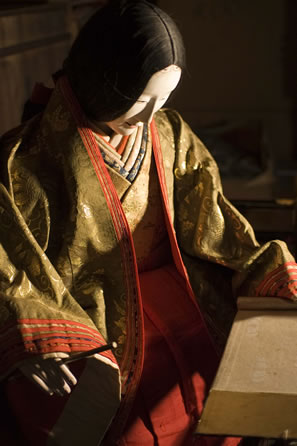 |
 |
 |
Every year on the tenth day of October the Otsu Matsuri (Otsu Festival) is held in the city of Otsu that is situated alongside Lake Biwa in the central part of Japan. This festival is one of the ritual observances of the TensonJinja(in the Edo period this shrine was known as Shinomiya Jinja and the festival was called Shinomiya Matsuri)and is designated as one of the People’s' intangible Cultural Properties by Shiga Prefecture. ln this festival thirteen "hikiyama" (Parade floats) are drawn through the streets of the city. The decoration of these hikiyama includes exquisitely dyed and woven draperies, beautiful metal fittings and wood carvings, and Paintings by artists of the first rank. These beautiful decorations cause the floats to be popularly regarded as ¨Moving Cultural Properties."Additionlally,the ¨karakuri ningyou" (moving mechanical dolls) a top the floats are one of the marvels of the Otsu Festival The origins of the Otsu Matsuri are traditionally described in the followingmanner.Near the beginning of the Edo Period(early 17th century),a person called Shiouri Jihei (Salt-selling Jihei)who lived in Kajiya-cho, put on a tanuki (abedger-like animal) mask for a dance honoring the gods during the annual festival and achieved great popularity for his Performance. A platform was constructed for him to perform on and was drawn through the streets of the city. Although this Practice for ten years, eventually Jihei became too old to Perform the dance. At this juncture, a mechanical doll of a tanuki striking his drum-like stomach was constructed and from 1622 (Genna 8)became a central feature of the festival parade. A newly constructed wheeled cart pulled by a group of children became l regular part of the Parade in 1635 (Kan'ei 12). And in 1638 (Kan'ei 15),a hikiyama float designed after the "yamahoko" floats of the famous Gion Matsuri in Kyoto was constructed・ This was the original model for the Present-day hikiyama floats. Over the following 141 -year period a total of thirteen hikiyama floats were constructed. However, the Edo period (1615-1868)festival parades included more than just the hikiyama floats. Masquerade processions, called ”nerimono,” also participated. ln the records for 1692 (Genloku 6)eight hikiyama floats and seventeen nerimono are listed for the festival procession. These represented all twenty-five for the local destricts that Participated in the making of the procession. Subsequently, some of the districts that had been represented by nerimonogradually changed over to the use of hikiyama floats. Due to strategic position on the principal inland transportation route(theTakaida road)the city of Otsu had a thriving economy during the Edo period.lt was due to this economic Prosperity that such gorgeous hikiyama floats couldbe Produced. Furthermore, being so close to Kyoto the latest cultural trends werequickly introduced to the city. This resulted in themes from No chanting, kyogen(comic theatre), and old Chinese stories being adopted for use in the naming ofthe hikiyama floats. The most striking feature of the hikiyama floats used in the otsu Matsuri arethe ”karakuri ningyo" or moving mechanical dolls. The names of the hikiyamafloats were derived from the famous scenes found in the popular performances andstories of their day that are enacted by the mechanical dolls on top of the floats.Although hikiyama floats surmounted by karakuri ningyo can be found in variousregions throughout Japan,it is thought that those of Otsu represent the oldeststyle, the performances of these mechanical dolls throughout the city streets drawsthe biggest applause from the spectators becoming one of the great attractions ofthe Otsu Matsuri. Furthermore, the decorations of the hikiyama floats are also splendid. Amongthe dyed weavings hung on the sides of the floats are sixteenth century tapestriesfrom Brussels. Among the dyed fabrics found on the Gekkyuden-zan float is atapestry with a depiction of Aeneas’ capture of the city of Troy from the Greekepic the Aenid. Other hikiyama floats are draped with gorgeous dyed weavingsthat include seventieth and eighteenth century Chinese k”o-ssu and embroideries,Japanese embroideries,etc. Additionally, the ceilings of the hikiyma floatsdelight the eyes of the audience with paintings by the best Kyoto artists. ln this way the Edo period townspeople of Otsu expressed their enthusiasm forthe festival by constructing these marvelous hikiyama . |